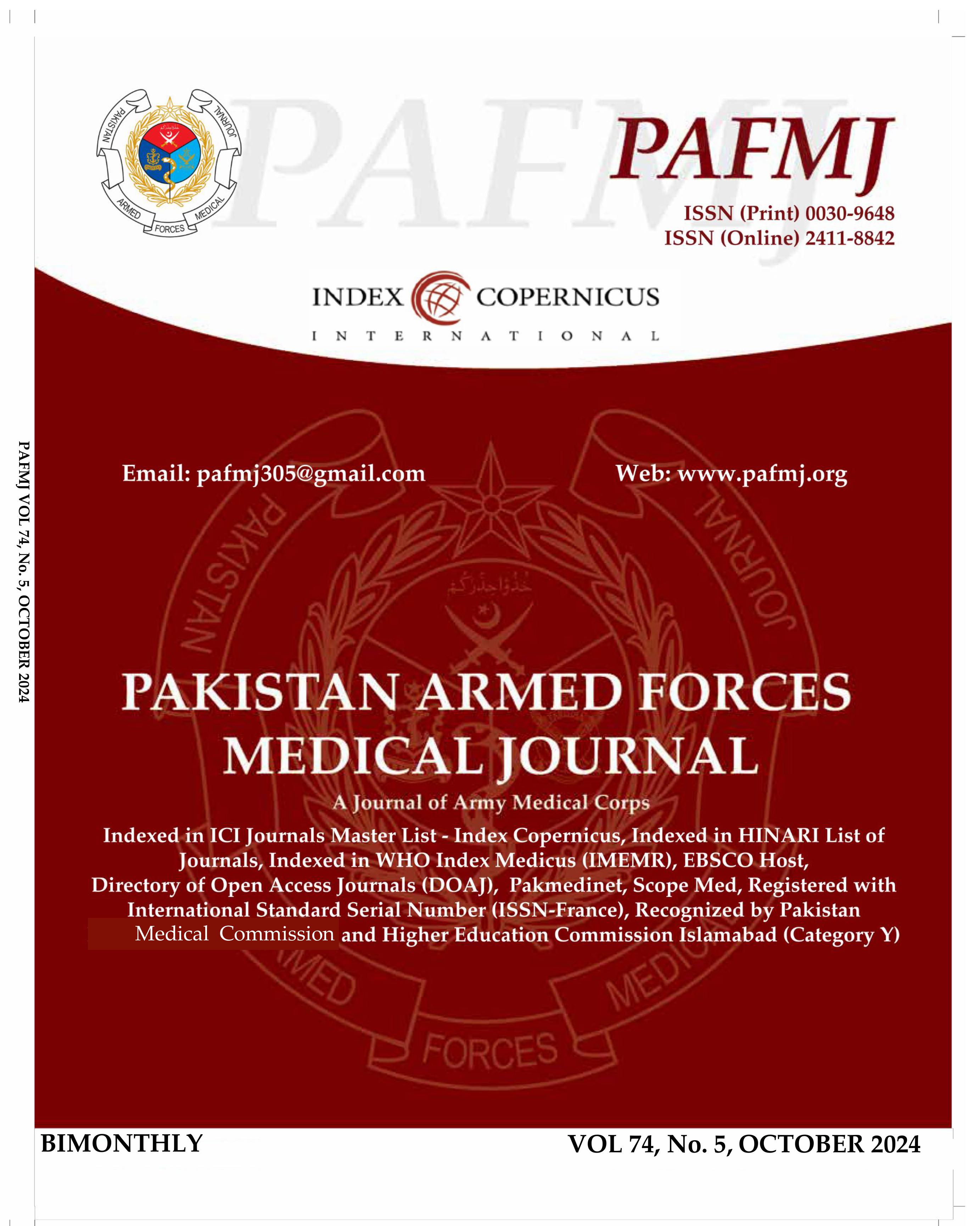Comparative Study on Different Clinical Decision-Making Tools in Pediatric Head Injury Cases
DOI:
https://doi.org/10.51253/pafmj.v74i5.9719Keywords:
CATCH, CHALICE, Head Injuries, PECARN, Pediatrics.Abstract
Objective: To carry out a comparative study on effective clinical decision-making tools between Canadian Assessment of Tomography for Childhood Head injury, Pediatric Emergency Care Applied Research Network (PECARN) and Children's Head injury Algorithm for the prediction of Important Clinical Events in pediatrics head trauma cases.
Study Design: Validation study.
Place and Duration of Study: Department of Surgery, Saif Shaheed Hospital, Haveli Kahota, Azad Kashmir, Pakistan, from Oct 2021 to Nov 2022.
Methodology: One hundred and fifty paediatric patients suffering from minor head injury were evaluated on clinical intervention decisions as per emergency procedures during the period of study. Sensitivity, Specificity, Positive Predictive Value and Negative Predictive Value of the selected diagnostic tests was checked.
Results: Based on the head CT positivity, PECARN was found to be 81.8% sensitive and 61.9% specific. Canadian Assessment of Tomography for Childhood show sensitivity of 90.9 % and specificity of 65.5%. CHALICE had sensitivity and specificity of 63.6% and 61.5% respectively. CHALICE was unable to identify a pathological CT result with statistical significance (p=0.17) however PECARN and CATCH rule proved significant (p<0.05). CATCH rule show highest positive predictive score of 17.2% and negative predictive score of 98.8%.
Conclusion: PECARN, CATCH, and CHALICE criteria are effective in deciding whether or not to perform Computerized Brain Tomography (CBT) scans on children with MHT, leading us to believe that employing these criteria could prevent unnecessary CBT scans.
Downloads
References
Ak R, Çelik NB, Erdoğan HD, Karaküçük AY, Gökdoğan S, Korkmaz S, et al. Evaluation of Three Clinical Decision Rules in Pediatric Patients with Minor Head Injury: PECARN, CHALICE and CHATCH. Evaluation 2023; 2(2): 33-40.
https://doi.org/10.4274/globecc.galenos.2023.69885
Uduma FU, Okere PCN, Ekpene UU, Nottidge TE. Computed tomographic imaging appraisal of traumatic brain injury in a tertiary hospital in South-South Nigeria: A 6-year review. Niger Med J 2020; 61(5): 252-256.
Sophie S, Schuster-James M, SmithDouglas H, SteinSherman C. Cost-effectiveness of biomarker screening for traumatic brain injury. J Neurotrauma 2019; 36(13).
https://doi.org/10.1089/neu.2018.6020
De Gonzalez AB, Salotti JA, McHugh K, Little MP, Harbron RW, Lee C, et al. Relationship between paediatric CT scans and subsequent risk of leukaemia and brain tumours: assessment of the impact of underlying conditions. Br J Cancer 2016; 114(4): 388–394. https://doi.org/10.1038/bjc.2015.415
Gizli G, Durak VA, Koksal O. The comparison of PECARN, CATCH, AND CHALICE criteria in children under the age of 18 years with minor head trauma in emergency department. Hong Kong J Emerg Med 2022; 29(1): 31–37.
https://doi.org/10.1177/1024907920930510
Meral Atiş G, Altay T, Atiş ŞE. Comparison of CATCH, PECARN, and CHALICE clinical decision rules in pediatric patients with mild head trauma. Eur J Trauma Emerg. Surg 2022; 48(4): 3123–3130. https://doi.org/10.1007/s00068-021-01859-x
Bhatti JA, Stevens K, Mir MU, Hyder AA, Razzak JA. Emergency care of traumatic brain injuries in Pakistan: a multicenter study. BMC Emerg Med 2015; 15: 1–7.
https://doi.org/10.1186/1471-227X-15-S2-S12
Lorton F, Poullaouec C, Legallais E, Simon-Pimmel J, Chêne MA, Leroy H, et al. Validation of the PECARN clinical decision rule for children with minor head trauma: a French multicenter prospective study. Scand J Trauma Resusc Emerg Med 2016; 24(1): 1–8.
https://doi.org/10.1186/s13049-016-0287-3
Bako D, Özer U, Beydoğan E. Computed tomography overuse in pediatric minor head trauma: insights from a single-center experience. Klin Pädiatr 2024; 236(01): 11-5.
https://doi.org/10.1055/a-2156-9780
Atabaki SM, Hoyle Jr JD, Schunk JE, Monroe DJ, Alpern ER, Quayle KS, et al. Comparison of prediction rules and clinician suspicion for identifying children with clinically important brain injuries after blunt head trauma. Acad Emerg Med 2016; 23(5): 566–575. https://doi.org/10.1111/acem.12923
Naseer N, Kapadia NN, Masud S. Validity of Pediatric Emergency Care Applied Research Network (PECARN) in Pediatric Trauma Patients-A Cross Sectional Study from a Tertiary Care Hospital in Pakistan. Ann King Edw Med Univ 2022; 28(1): 58–63. https://doi.org/10.21649/akemu.v28i1.4994
Bozan Ö, Aksel G, Kahraman HA, Giritli Ö, Eroğlu SE. Comparison of PECARN and CATCH clinical decision rules in children with minor blunt head trauma. Eur J Trauma Emerg Surg 2019; 45: 849–855.
https://doi.org/10.1007/s00068-017-0865-8
Easter JS, Bakes K, Dhaliwal J, Miller M, Caruso E, Haukoos JS. Comparison of PECARN, CATCH, and CHALICE rules for children with minor head injury: a prospective cohort study. Ann Emerg Med 2014; 64(2): 145–152.
https://doi.org/10.1016/j.annemergmed.2014.01.030
Crowe L, Anderson V, Babl FE. Application of the CHALICE clinical prediction rule for intracranial injury in children outside the UK: impact on head CT rate. Arch Dis Child 2010; 95(12): 1017–1022.
https://doi.org/10.1136/adc.2009.174854
Dalziel K, Cheek JA, Fanning L, Borland ML, Phillips N, Kochar A, et al. A cost-effectiveness analysis comparing clinical decision rules PECARN, CATCH, and CHALICE with usual care for the management of pediatric head injury. Ann Emerg Med 2019; 73(5): 429–439.
https://doi.org/10.1016/j.annemergmed.2018.09.030
Babl FE, Borland ML, Phillips N, Kochar A, Dalton S, McCaskill M, et al. Accuracy of PECARN, CATCH, and CHALICE head injury decision rules in children: a prospective cohort study. Lancet 2017; 389(10087): 2393–2402.
https://doi.org/10.1016/j.jemermed.2017.05.015
Proctor A, Lyttle M, Billing J, Shaw P, Simpson J, Voss S, et al. Which elements of hospital-based clinical decision support tools for the assessment and management of children with head injury can be adapted for use by paramedics in prehospital care? A systematic mapping review and narrative synthesis. BMJ open 2024; 14(2): e078363.
https://doi.org/10.1136/bmjopen-2023-078363
Wickbom F, Calcagnile O, Marklund N, Undén J. Validation of the Scandinavian guidelines for minor and moderate head trauma in children: protocol for a pragmatic, prospective, observational, multicentre cohort study. BMJ Open 2024; 14(4): e078622.
Downloads
Published
Issue
Section
License
Copyright (c) 2024 Mohsin Shahzad, Ammar Yasir, Saqib Islam, Khurram Hussain, Raja Nand, Hafiz Asghar Ali

This work is licensed under a Creative Commons Attribution-NonCommercial 4.0 International License.















